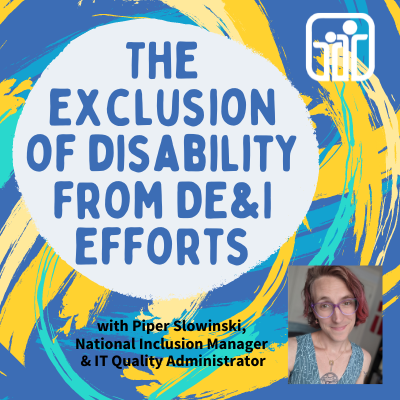America’s Recovery: Powered by Inclusion, the 2021 National Disability Employment Awareness Month theme, reflects the importance of equal access to employment and community involvement as we navigate our country’s recovery from the Covid-19 pandemic.
In the continuous wake of social justice issues, the public expects organizations to be increasingly transparent with their diversity, equity and inclusion (DE&I) policies. However, according to a report by Josh Bersin, 76% of companies have no diversity or inclusion goals, and approximately 80% are “just going through the motions and not holding themselves accountable.” The results of this study are based on responses from 804 HR professionals working across a range of industries.
Before getting into the crux of the issue, it’s important to have a working understanding of what DE&I is. Vernā Myers, activist and VP of Inclusion Strategy at Netflix, offers a simplified way to think about DE&I. “Diversity is about who is represented in the organization, whereas inclusion speaks more to who is respected, expected and integrated into an institution.” Myers likens diversity and inclusion to aspects of attending a dance: “Diversity is being invited to the party. Inclusion is being asked to dance.”
 Piper Slowinski, PYD’s National Inclusion Manager and IT Quality Administrator, said, “There’s been lots of protests, lots of activism around racial equity, around gender equity, around queer inclusion… disability hasn’t gotten as much attention on a national scale.” Slowinski works with organizations on behalf of PYD to help the organizations be more inclusive in the work they do, specifically their work in relation to disability inclusion and accessibility.
Piper Slowinski, PYD’s National Inclusion Manager and IT Quality Administrator, said, “There’s been lots of protests, lots of activism around racial equity, around gender equity, around queer inclusion… disability hasn’t gotten as much attention on a national scale.” Slowinski works with organizations on behalf of PYD to help the organizations be more inclusive in the work they do, specifically their work in relation to disability inclusion and accessibility.
Our workplaces have more people with disabilities than employers know of. According to a 2017 Center for Talent Innovation study, as many as 30% of employees have disabilities both visible and invisible, but on average only about 3.2% disclose having a disability to their employers. These employees fear discrimination regardless of visibility as well exclusion in the forms of ignored ideas, insults, avoidance, discomfort, and misjudgment.
“Unless someone is in the room, you can’t listen to them, you can’t know their perspectives. Disability can’t be included in DE&I work until their voices are in the room,” said Slowinski. They attribute the often-absent consideration of people with disabilities in DE&I to a lack of intersectional thinking. According to Slowinski, organizations put their DE&I focuses into discrete buckets that do not overlap or account for employees that fall into more than one of those buckets.
 PYD’s youth-serving work, consulting work and trainings might seem very different to one another; however, each effort works towards the same goal of enacting societal-level change, whether it’s by raising up the skills and abilities of youth with disabilities or by educating and preparing communities and employers to be fully inclusive of youth with disabilities. PYD offers resources to support organizations in assessing and improving their workplace culture and business practices to achieve their inclusion goals.
PYD’s youth-serving work, consulting work and trainings might seem very different to one another; however, each effort works towards the same goal of enacting societal-level change, whether it’s by raising up the skills and abilities of youth with disabilities or by educating and preparing communities and employers to be fully inclusive of youth with disabilities. PYD offers resources to support organizations in assessing and improving their workplace culture and business practices to achieve their inclusion goals.
For more information about the benefits of investing in disability inclusion, see “Our Stories” blog about fostering inclusion through internships.
*Both charts are sourced from the Disability and Inclusion: US Findings report.
This article was written by Anna Welch of the BU PRLab

